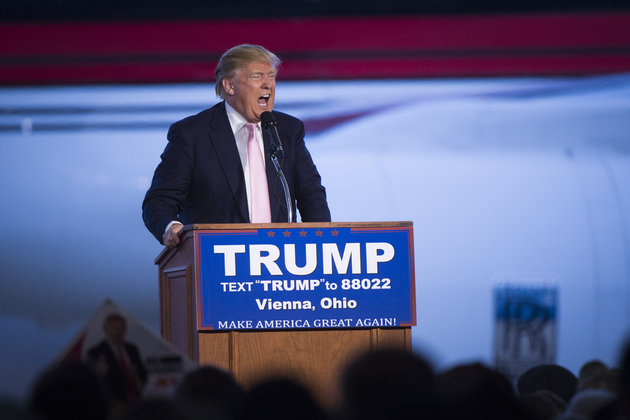
Republican front-runner Donald Trump on Sunday floated the idea of paying the legal fees of a white supporter who sucker-punched a black man leaving a rally. Later that day, he claimed “no responsibility” for political violence, suggesting instead that protesters are dangerous and that his supporters are right to “hit back.” He even blamed Democratic candidate Sen. Bernie Sanders (I-Vt.) for sending protesters to disrupt his rallies, and threatened to sic his supporters on Sanders in retaliation.
Extreme political movements like Trump’s often go hand-in-hand with street violence. But organized militias like Adolf Hitler’s brown shirts and Benito Mussolini’s black shirts don’t spring up overnight. They evolve. Here’s how the process works.
Phase One: Anger
The election of President Barack Obama in 2008 immediately sparked a spike in anti-black hate crimes. The suspicion and resentment toward Obama began during his campaign, most notably with the birther movement that questioned whether he was born in the United States. (He was.) Some Americans considered Obama not merely a political opponent but a foreign “other,” unworthy of the respect citizens typically accord to presidents.
Trump, who helped elevate birtherism to national prominence, has fanned the flames of white Americans’ rage, appealing to their most base nationalistic instincts.
The data show that Trump supporters are more likely to be economically insecure. But that doesn’t explain the timing of Trump’s rise, since the fortunes of working-class whites, like working-class people of color, have been declining for decades. As Jamelle Bouie argues persuasively in Slate, Trump’s followers apparently view Obama’s power as a sign that they have lost the political privilege they once enjoyed just because they were white. Sixty-one percent of Trump’s supporters have continued to believe Obama is a foreign-born Muslim, according to a Public Policy Polling survey released in September.
Beliefs like that aren’t uncommon among supporters of tyrants and demagogues.
“What illiberal leaders across the world share is a very deep ideological or nationalistic motivation and sense of being in an in-group where people do not see their opponents just as opponents but as enemies in an existential sense,” said Shadi Hamid, a senior fellow at the Brookings Institution who authored the book Temptations of Power: Islamists and Illiberal Democracy in the Middle East.
“That contributes to paranoia, conspiracy theories and overall it strengthens the existential tenor of politics, which is something we are not used to,” he added.
But prior to Trump’s presidential run, many mainstream Republican leaders condemned the most excessive racist attacks on Obama. While running for president on the GOP ticket in 2008, Sen. John McCain famously chastised a woman who called Obama “an Arab.”
Republican leaders also stood in solidarity with black Americans in the wake of heinous hate crimes. After a white supremacist massacred black churchgoers in Charleston, South Carolina, in June, the state’s conservative Republican governor, Nikki Haley, pushed for the Confederate flag to be removed from the state Capitol grounds.
Phase Two: Excusing Violence
The next phase in the evolution of organized violent groups comes when leaders stop condemning violence and start excusing it. That’s what Trump’s doing now — and mainstream Republican leaders have been slow to rebuke him for it.
Without condemnation from mainstream Republican leaders, Trump-associated violence has spread.
In August, two Boston brothers who beat up a homeless Latino man cited Trump as inspiration. Trump said he had not heard of the incident, and that it would “be a shame” if it had happened. But he also suggested the incident was a product of his supporters’ passion. “I will say, the people that are following me are very passionate,” he said. “They love this country, they want this country to be great again.”
At a November rally, he said of a black protester who’d been beaten, “Maybe he should have been roughed up, because it was absolutely disgusting what he was doing.”
In February, he told his supporters at a rally, “If you see somebody who’s getting ready to throw a tomato, knock the crap out of him, would you?” He then promised to cover their legal fees. At another rally that month, Trump talked about a protester being taken out “on a stretcher,” adding, “I’d like to punch him in the face.”
When evidence first surfaced earlier this month that Trump’s top aide assaulted a reporter at an event, Trump accused the reporter of making the story up.
The other GOP candidates have seemed reluctant to renounce Trump. At a Republican debate on March 3, his three opponents at the time committed to supporting him if he were to become the party’s nominee.
Mitt Romney, the party’s nominee in the 2012 election, had attacked Trump in a speech earlier that day — refuses to entertain the idea of voting for Hillary Clinton, who is likely to be the only viable alternative.
Just this month, as a protester was being taken out of an event, Trump said, “Try not to hurt him. If you do, I’ll defend you in court, don’t worry.”
Sen. Lindsey Graham (R-S.C.) summarized the GOP response to the candidate on Tuesday.
“I think our party leadership’s been light on Trump,” he told The Huffington Post.
That may be because the Republican establishment — like elite classes elsewhere — fomented the rage of the masses for political convenience, but couldn’t foresee, let alone contain, what would happen when it spiraled out of control.
“The danger is that if you indulge the worst instincts too much, you can no longer control what you have created,” Hamid said.
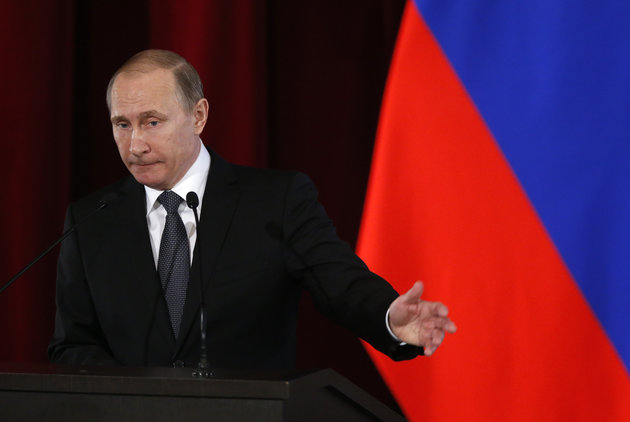
Phase Three: Legal Impunity
The Trump supporter who sucker-punched a black protester in Fayetteville, North Carolina, did so in full view of multiple police officers, yet he wasn’t arrested until video of the assault provoked an outcry the next day. HuffPost has documented that the number of violent incidents at Trump rallies is higher than the numbers of arrests for assault.
The lack of response from law enforcement and the Republican Party, when combined with the support of Trump himself, likely leads some of his followers to conclude that violence is acceptable, even desirable, and can be carried out with impunity.
Incendiary, coded rhetoric is key. Even in Vladimir Putin’s Russia, rhetoric does most of the work. Putin and his subordinates routinely describe political disputes as us-versus-them struggles. Implying that the regime’s political opponents are on the U.S. State Department payroll is a common tactic.
“You will probably have a very difficult time finding Putin making statements instigating violence against opponents,” said Sean Guillory, a scholar who analyzes Russian politics. “The way that violence occurs in Russia is that there is a delegitimization of opponents and criticism.”
This delegitimization creates an environment in which individuals, oligarchs or regional rulers feel empowered to commit acts of violence against dissenters.
The way that violence occurs in Russia is that there is a delegitimization of opponents and criticism.
- Sean Guillory, Russia scholar
Sometimes, Putin or his spokesman Dmitri Peskov will offer a lukewarm condemnation of a journalist or activist being beating or killed.
“The press will ask Dmitri Peskov, or [Putin] will be asked directly about it,” Guillory said. “You will not get an explicit condemnation, but instead get a blanket statement like, ‘People should follow the law.’”
Trump has not even gone that far, however. During last week’s GOP debate, CNN’S Jake Tapper cited several examples of the candidate encouraging crowds to get physical with protesters. Trump again attributed the attacks to his supporters’ anger and passion — and insisted that the protesters were really the violent ones.
The ground-up, spontaneous nature of Trump’s support may make it even easier for him to take advantage of mob violence than it was for Putin, said Mark Ames, a founder of The Exile, an English-language newspaper in Russia that Putin shut down in 2008.
“It probably almost works better if it is not more organized,” Ames, now a reporter for Pando, said. “It is all so much more ad hoc, reality TV.”
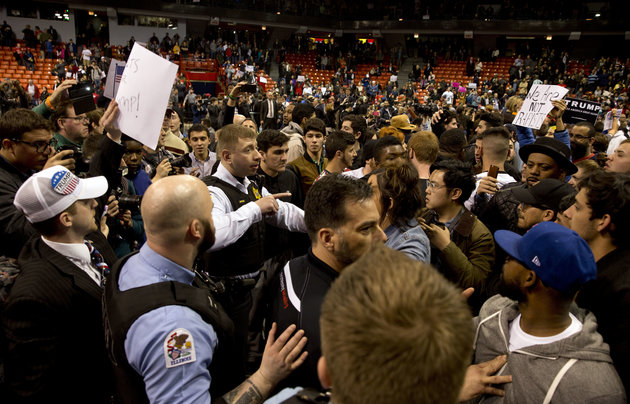
Phase Four: The Opposition Fights Back
Demonstrators have been a frequent presence at Trump rallies from the start of his campaign, but were typically isolated individuals until recently. Now, with the help of large liberal groups like MoveOn, activists are working in a more organized fashion to disrupt Trump. On Friday, for example, thousands of protesters converged on a rally in Chicago, leading to the event getting canceled.
The presence of large, organized protests has further radicalized Trump’s supporters. Some have already begun discussing bringing guns to rallies and voting booths in order to “protect” themselves from liberal protesters.
The prospect of the GOP’s establishment wing thwarting Trump’s nomination in a brokered party convention holds the potential for even greater backlash. Trump suggested on Wednesday that allowing a contested convention — even if he failed to win a majority of delegates and outright earn the nomination — would result in riots.
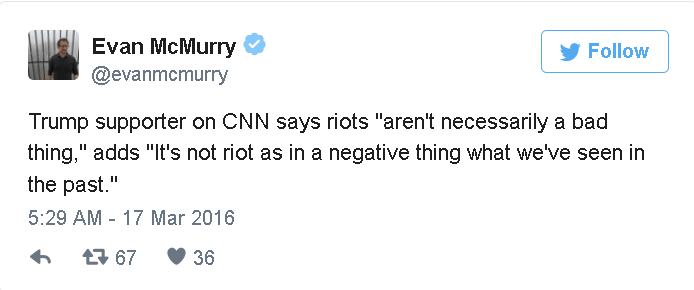
“What does that mean for our norms as a country, and the idea of respecting democratic outcomes even if you disagree with them?” asked Hamid, who has studied the effects of the military coup in Egypt. “If millions of Trump supporters felt that the democratic will wasn’t respected, that’s where you could see real polarization that could spill into even more violence.”
Phase Five: Going On Offense
Right now most of the Trump rally violence, even against protesters, has been disproportionately directed at people of color.
Globally, the pattern is the often the same: Immigrants are targeted first, then other minorities. Finally, the violence turns directly against whatever communist, socialist, conservative, liberal or progressive opposition exists.
Trump previewed this approach in a Twitter threat directed at Sanders — who he has taken to calling “our Communist friend” — on Sunday.
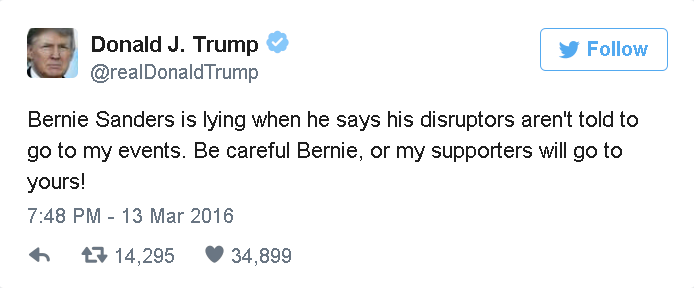
The more Trump succeeds politically, the more brazen he and his supporters are likely to become, said Jeffrey Herf, a historian of fascism at the University of Maryland.
“If Trump succeeds against all expectations in getting the Republican nomination, and against even greater expectations, wins the presidency, he will not become a more reasonable man,” Herf said. “It is the kind of thing that feeds his ego and his sense of being absolutely right. It is the kind of thing that could lead to midnight raids to deport Mexicans en masse.”
Herf, like many experts, does not believe Trump is a fascist. But he notes that Italian and German elites’ “underestimation” of fascists was a hallmark of their rise in the 20th century in those countries. Similarly, he said, elites in the U.S. failed to foresee Trump’s ascendancy.
Now that the violence is escalating, members of the establishment are calling for calm.
“Donald Trump called this morning, and we had a good conversation,” Senate Majority Leader Mitch McConnell (R-Ky.) told reporters Tuesday on Capitol Hill. “I took the opportunity to recommend to him that no matter who may be triggering these violent, uh, expressions or conflict that we’ve seen at some of these rallies, it might be a good idea to condemn that and discourage it, no matter what the source of it is.”
McCain, who tamped down xenophobia eight years ago, is left with little power, particularly after Trump denigrated his prisoner-of-war experience and was only rewarded in the polls.
HuffPost told McCain that Trump supporters are now talking about arming themselves. “I hope that’s not a serious comment,” McCain replied. “I just think that that would be very unfortunate and I hope that nobody is seriously thinking about that.”
Graham said Trump bears responsibility for his supporters’ actions.
“I can’t tell rallygoers what to do. I can tell you we’re a rule of law nation,” the senator said. “And I can say that Mr. Trump’s rhetoric has created hateful attitudes. I think he is one of the reasons these attitudes exist. It’s not happening at other people’s rallies. All I would say to Mr. Trump is that you need to get control over the process here. You’re doing a pretty lousy job of it.”
Polls and reporting indicate that Trump’s supporters have actually become more deeply enamored with the candidate, even as violence has escalated. There are no institutions that can prevent people from voting for a man who incites violence — only norms. And Trump is revealing just how weak those norms are.
“I was never taught in school that coups, for example, are unacceptable, but it was something I absorbed as an American,” Hamid said. “What happens when those norms erode?”
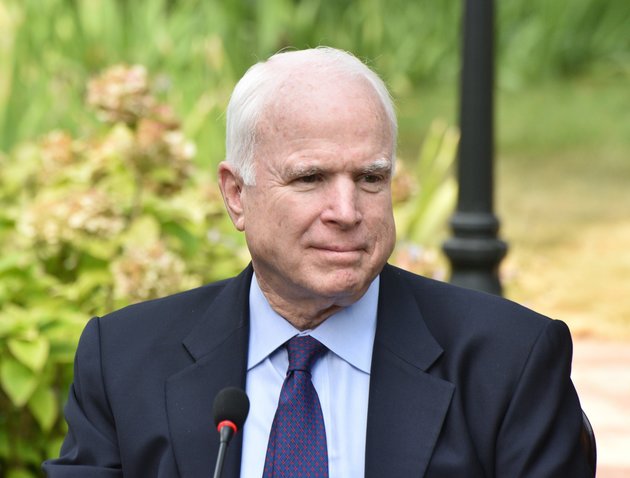
Phase Six: Picking A Shirt (Or Hat) Color
Once violence is normalized, it’s only a short jump to it becoming organized.
Trump’s thugs might end up looking more like those of Putin (who he openly admires) or the “colectivos” who back the government of Venezuelan President Nicolas Maduro, and less like Hitler’s brown shirts or Mussolini’s black shirts. Turkey, India, Israel and Hungary have all seen a steep rise in and a mainstreaming of ethno-nationalism in recent years, and along with it has come both organized and random street violence.
These are unofficial bodyguards and sometimes they can adopt a little more aggressive position. Peter Hakim, the Inter-American Dialogue
Pro-government thugs have been a feature of Caribbean and Latin American political life, for example, for decades, said Peter Hakim, a senior fellow at the Inter-American Dialogue, a network of policy experts across the Western Hemisphere.
He sees Trump supporters who have vowed to retaliate against liberal protesters as a similar threat.
“This is often how these groups start. With young kids, this is the kind of bravado they like to use or act on,” he said. “You get people who have not communicated with the campaign who begin to defend their turf. Maybe there is someone on the staff that’s close to them. Maybe they hire a turf protector onto the staff. These are unofficial bodyguards and sometimes they can adopt a little more aggressive position.”
And sometimes a lot more.
- Publish my comments...
- 0 Comments
